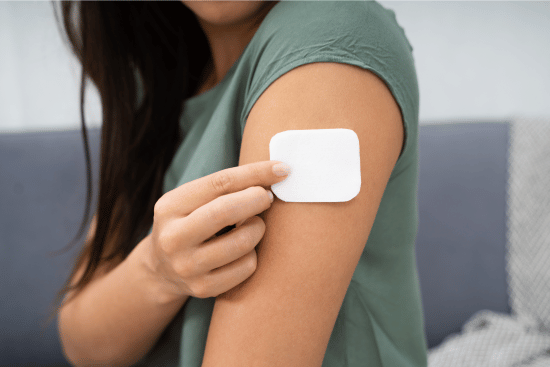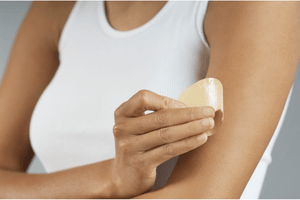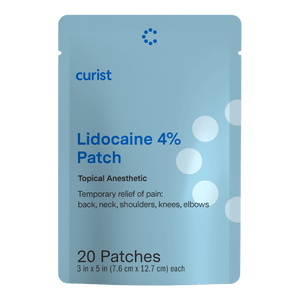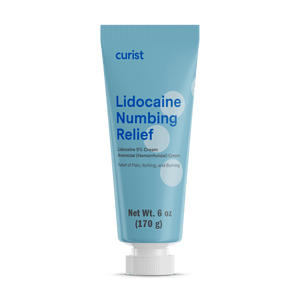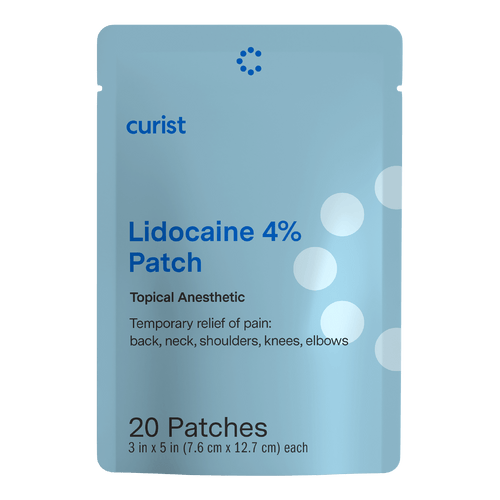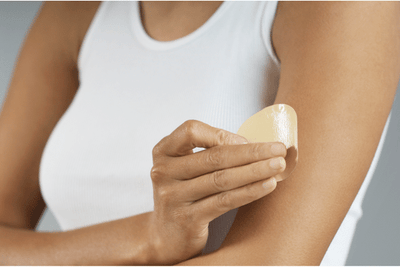By Amelia McGill, The University of Texas at Austin College of Pharmacy
Curist delivers over-the-counter medicines to your door at a fraction of the price of traditional brands. We hope everyone stays safe and healthy during this time.
What are the Benefits of Using Pain Patches? What are Pain Patches Used to Treat?
Pain patches (e.g. lidocaine 4% patch) can be used to temporarily relieve symptoms of pain or itching in a localized area. The medication itself is manufactured within the patch, and once the patch is adhered to the skin, the medicine will slowly absorb over an extended period of time. Typically, pain patches can be used for up to 8 to 12 hours per application, depending on the specific product.
The benefit of using pain patches include symptom relief while providing a no-mess application and long-lasting effect. Pain patches can easily adhere to treatment sites (e.g. upper arm, legs, thighs, back, etc.), so they will not get rubbed off like other creams and ointments. Additionally, most pain patches can be cut into fit a specific shape and size for the targeted area.
Specifically, pain patches can treat symptoms such as burning or itching caused by nerve pain, sore muscles in the back, neck, shoulders, knees, or elbows, and other minor ailments. Pain patches should not be used on an open wound, severe burns, cracked or inflamed skin, or for treating non-skin-related conditions (i.e. headaches).
What are the Different Strengths of Lidocaine Patches Available?
Lidocaine patches are available at varying strengths. Over-the-counter (OTC) lidocaine patches are manufactured with a maximum strength of 4% lidocaine. Strengths above lidocaine 4% would require a doctor’s prescription.
At Curist, we offer the strongest strength of lidocaine available OTC in our Lidocaine 4% Patch which includes twenty lidocaine 4% patches per pouch. Any lidocaine patch at a stronger concentration (i.e. higher than 4% lidocaine) would require a doctor’s prescription and may cost upwards of $1,000.
What is the Difference Between Lidocaine Patches vs Icy Hot Patches vs Biofreeze Patches?
The main difference between lidocaine patches, Icy Hot patches and Biofreeze patches is their mechanism of action. Specifically, lidocaine patches are anesthetics, while traditional Icy Hot patches and traditional Biofreeze patches are counterirritants. As an anesthetic, lidocaine works by blocking nerve signals and temporarily limiting sensations or pain. Lidocaine patches are generally safe and well-tolerated. Counterirritants, on the other hand, create temperature sensations (hot or cold) to limit painful sensations by distracting the brain using active ingredients such as camphor, menthol, methyl salicylate, and capsicum. As the names imply, traditional Biofreeze patches create a cooling sensation and Icy Hot patches start cold and end warm. Biofreeze patches often have menthol as the main active ingredient, whereas Icy Hot often have menthol and methyl salicylate as active ingredients. These patches are also generally safe and well-tolerated but can have a strong odor.
Are Lidocaine Patches Anti-Inflammatory? Are Icy Hot Patches Anti-Inflammatory? Are Biofreeze Patches Anti-Inflammatory?
No, lidocaine patches are not anti-inflammatory. Lidocaine patches only temporarily block nerve signals, thus providing temporary pain relief but lidocaine patches do not treat the underlying cause of pain, such as inflammation.
Yes, Icy Hot patches can be anti-inflammatory. Icy Hot patches contain methyl salicylate which is a rubefacient, which will cause vasodilation and increase blood flow. Methyl salicylate is a salicylate, similar to Aspirin, and can reduce substances that cause pain or inflammation. Additionally, Icy Hot patches contain a second active ingredient (menthol) which creates a cooling sensation to distract the brain from pain and reduce inflammation in the same way ice does. Icy Hot patches create cold and warm sensations to distract the brain from pain and treat the local inflammation near the patch.
No, Biofreeze patches do not contain anti-inflammatory active ingredients. Instead, Biofreeze patches work by utilizing one active ingredient (menthol) to create a cooling sensation to distract the brain from pain and reduce inflammation in the same way ice does. Biofreeze is often called “cold therapy.”
To treat systemic inflammation, or inflammation around the body, patients should take non-steroidal anti-inflammatory drugs (NSAIDs), such as naproxen and ibuprofen available over-the-counter, which have systemic anti-inflammatory properties. If you are unsure whether the cause of your pain is due to an underlying inflammation or not, make sure to consult with your healthcare provider or a local pharmacist first.
Which Patch Works Best for Back Pain: Lidocaine Patches, Icy Hot Patches or Biofreeze Patches?
Comparing Icy Hot patches vs. Biofreeze patches vs. lidocaine patches, of the three, lidocaine patches typically work best for back pain caused by sore muscles as lidocaine patches work by temporarily blocking nerve signals that cause the pain or aches. However, if you are experiencing back pain due to potential underlying inflammation, lidocaine patches will not treat the underlying problem, so consider using NSAIDs and discuss with your medical provider.
Which Patch Works Best for Arthritis: Biofreeze Patches, Lidocaine Patches or Icy Hot Patches?
IcyHot typically works best for arthritis due to its mimicking effects of “ice-sensation-effect” with menthol and slightly decreasing inflammation with methyl salicylate. However, to treat the underlying cause of joint inflammation (arthritis), you may need to take an oral anti-inflammatory medicine called NSAIDs, like ibuprofen (Motrin or Advil) or naproxen (Aleve), or apply topical NSAIDs, like diclofenac gel. Read the Curist article on comparing the benefits of lidocaine vs diclofenac gel to learn more about these options.
Which Patch Works Best for Knee Pain: Icy Hot Patches, Biofreeze Patches or Lidocaine Patches?
Biofreeze or Icy Hot patches typically work best for knee pain as the knee is classified as a joint. Knee pain can be caused by tendonitis, in which case ice is recommended. Both Biofreeze and Icy Hot patches are able to mimic the effects of ice and may provide better relief for knee pain.
Which Patch Works Best for Nerve Pain: Lidocaine Patches, Icy Hot Patches or Biofreeze Patches?
Lidocaine patches typically work best for nerve pain as they temporarily block nerve signals transmitting the pain sensations. Icy Hot and Biofreeze patches use temperature sensations to distract the brain but do not impact the transmission of those nerve pain signals. If you are experiencing severe nerve pain that is affecting your normal daily activities, this may indicate a separate condition known as neuropathy. In this case, you will need a doctor’s visit and prescription medications to help relieve your nerve pain. If you are unsure what type of pain you have, make sure to seek help and guidance from your healthcare provider or a local pharmacist.
Can I Use Multiple Lidocaine Patches At Once? Can I Use a Lidocaine Patch with Icy Hot or Biofreeze?
No, it is not recommended to use multiple lidocaine patches at once. Although lidocaine is generally considered safe and well-tolerated, combination of multiple lidocaine patches may increase the risk of using too much lidocaine.
However, if you feel like you need additional pain relief, you may consider using an anesthetic patch (i.e. lidocaine patch) at the site of discomfort and another counterirritant product (e.g., Icy Hot or Biofreeze patches) nearby as they have different active ingredients and mechanisms of action
Can I Sleep with a Lidocaine Patch, Biofreeze Patch, or Icy Hot Patch On?
Yes, you can sleep with a lidocaine patch, Biofreeze patch, or Icy Hot patch. They are all considered safe for night-time use. It is important to keep in mind that any pain patch should only be limited to less than 12 hours of use, and in some cases up to 8 hours depending on the instructions. You should not sleep with these patches on for more than 12 hours.
Can I Use a Heating Pad over a Lidocaine Patch, Icy Hot Patch or Biofreeze Patch?
No, it is not recommended to use a heating pad over a lidocaine patch, Icy Hot patch, or Biofreeze patch, mainly because heat can speed up the absorption of the medication into the skin and can expose you to a higher amount than recommended in a given timeframe. Additionally, Icy Hot and Biofreeze products have cooling effects, so it can be difficult for users to gauge when a heating pad is getting too hot or not, which may cause potential blistering or skin burning.
Lidocaine 4% patches are available at Curist at a fraction of the price of other lidocaine patches.
